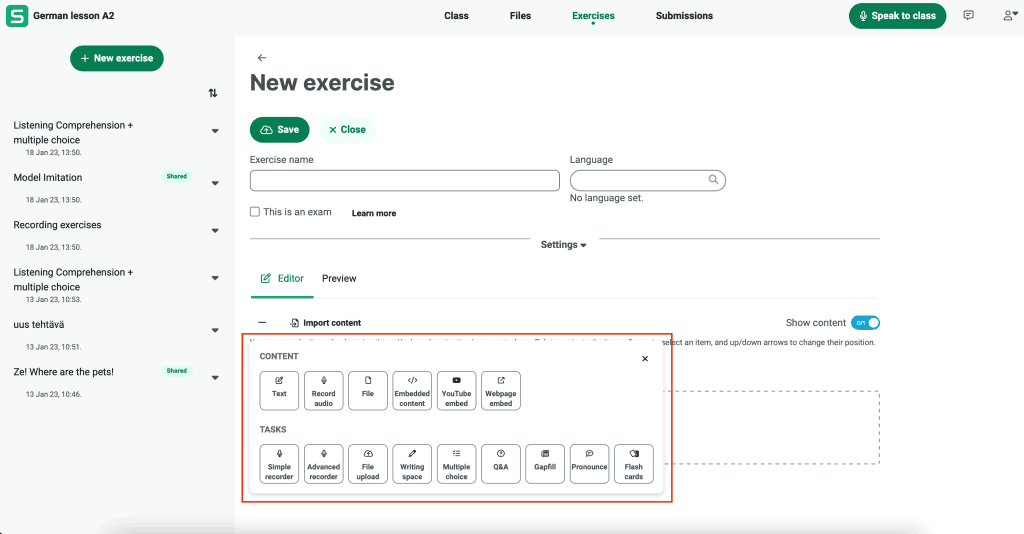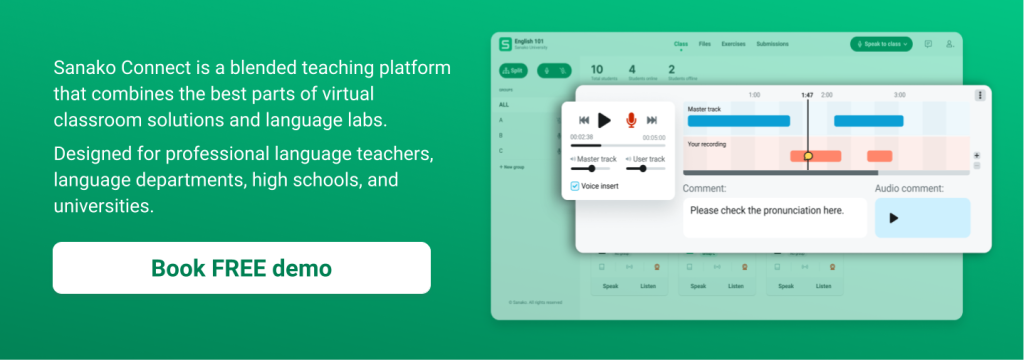With customers in 114 countries and users in over 50,000 classrooms, Sanako is well-positioned to understand the key challenges that language educators face in their daily teaching practice. Currently, engaging students and keeping them motivated to learn is a key focus for educators and they’re deploying a wide variety of different pedagogical approaches to keep lessons fresh and relevant.
One increasing popular language teaching method is CLIL or Content and Language Integrated Learning. This blog post explores how CLIL works and how educators can make the most of its unique approach. We’ll also explore how Sanako Connect can be powerfully deployed to support the full range of CLIL lesson activities in the classroom and remotely.
What is CLIL?
Content and Language Integrated Learning, or CLIL, is an umbrella term which describes the teaching of subjects to students in a language that is not their own.
As such, it can be applied to learning formal curriculum subjects in a different language (e.g Maths in Finnish or Geography in Chinese), although our focus will be it’s application in language learning. In a CLIL language learning class, educators deliver all of the content in the target language and focus learning around a stand-alone topic such as cookery, cinema or literature.
In CLIL lessons, language educators design tasks which allow learners to use their target language as they work through the new subject content. Educators are encouraged to see themselves as experts in their topic teaching a group of native speakers, without needing to translate or explain at every stage. In fact if students think that you’re actually delivering a cookery lesson in Japanese rather than a Japanese language class, then so much the better!
The CLIL approach therefore has many advantages for both learners and educators.
-
Language is used to learn as well as to communicate;
-
Fluency is more important than accuracy in CLIL lessons, which reinforce that making errors is a natural part of language learning;
-
CLIL lessons closely reflect real-life scenarios or issues. These tend to naturally engage learners and increase their study motivation;
-
Lessons also usually focus on language acquisition rather than enforced learning or learning by rote techniques;
-
CLIL materials are often characterised by lots of visual resources and support to provide context and meaning. This allows lower level language learners to access higher level content.
Challenges associated with CLIL
In a recent post on the Sanako blog, we identified a number of common challenges associated with delivering lessons using the CLIL approach. We noted that:
- It can be difficult for students at first as they may struggle to understand both language and lesson content.
- Delivering the lesson content might also require additional work by the educator to prepare suitable materials which aid understanding of key concepts.
- Educators will also need to carefully scaffold content to enable students to progress.
- More frequent questioning may also be required to ensure that students are learning/understanding and are on track.
How can you use CLIL teaching approach in your language classroom?
As we noted in our earlier post, a successful CLIL lesson should, according to the 4Cs curriculum (Coyle 1999), incorporate elements of each of the following:
- Content – Progression in knowledge, skills and understanding related to specific elements of a defined curriculum;
- Communication – Using language to learn whilst learning to use language;
- Cognition – Developing thinking skills which link concept formation (abstract and concrete), understanding and language;
- Culture – Exposure to alternative perspectives and shared understandings, which deepen awareness of otherness and self.
In his article ‘CLIL: A lesson framework’, Steve Darn from the Izmir University of Economics, expands on this to propose that “all four language skills should be combined” through a four-stage CLIL lesson framework. Darn identifies that:
- Listening is a normal input activity, vital for language learning
- Reading, using meaningful material, is the major source of input
- Speaking focuses on fluency. Accuracy is seen as subordinate
- Writing is a series of lexical activities through which grammar is recycled.
When delivering a CLIL lesson, educators should provide resources that support a variety of tasks to cater for all learning abilities and preferences. This might, for example, include listening activities such as confirming key information, labelling graphics or completing the gaps in a piece of text. Or speaking activities such as class surveys, prompted conversations and presentations.
How can Sanako Connect help language teachers to deliver CLIL lessons?
Sanako understands that there’s no right way to deliver a language lesson. Every educator has their own unique approach to teaching each class. But it’s important that our products and solutions are highly flexible and are able to support the widest variety of different teaching approaches, including CLIL.
However, there’s one constant that underpins every great lesson – high-quality lesson material and resources. Sanako makes it really easy for teachers to upload a wide variety of learning material for students to use. Any number of PDFs, presentations, videos and web pages can, for example, be easily attached to the online lesson plan. Making Sanako Connect the perfect platform to share these materials with students wherever they are learning.
Connect also helps teachers to maximise students’ opportunities to practice and develop their skills in the vital areas of listening, speaking, reading and writing.
At the heart of Sanako Connect, for example, educators can easily divide students into pairs or small groups for conversation practice. Each group of students can talk simultaneously without distracting each other. Teachers can listen in or talk with different groups to assist as required. All conversations can be easily downloaded and reviewed for comment.
In Sanako Connect, educators are also able to set students tasks that test their reading and writing skills. Connect’s flexibility enables teachers to upload stimulus material to which students can respond with detailed written answers of any length. It also supports teachers to create quizzes to test students’ spelling, understanding and grasp of key grammatical concepts.
If you’d like to find out more about how Sanako Connect language teaching software can help language teachers to deliver Content and Language Integrated Learning (CLIL), please contact us now to arrange your free demo!


